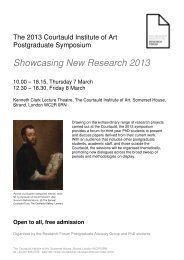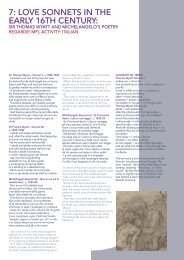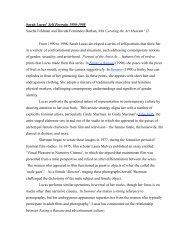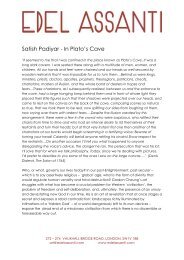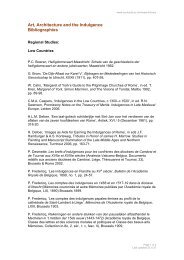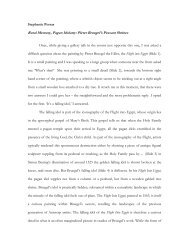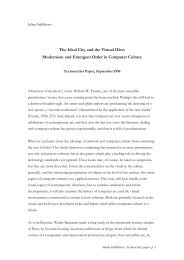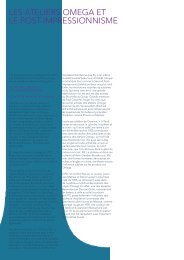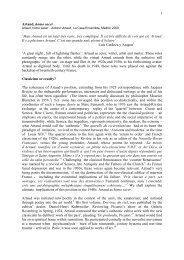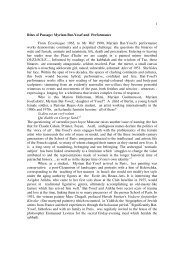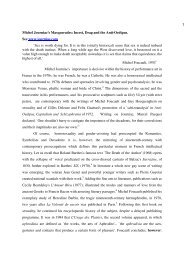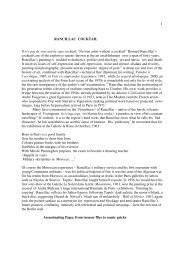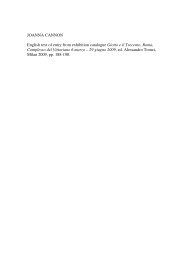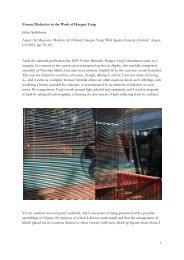Iluna gordelekuan/ Oscuridad en el refugio - The Courtauld Institute ...
Iluna gordelekuan/ Oscuridad en el refugio - The Courtauld Institute ...
Iluna gordelekuan/ Oscuridad en el refugio - The Courtauld Institute ...
Create successful ePaper yourself
Turn your PDF publications into a flip-book with our unique Google optimized e-Paper software.
forms of the H<strong>el</strong>met Heads were also read as sub-human: Digby wrote of the 1940 H<strong>el</strong>met<br />
Head (LH 212) as being ‘a curious structure which contains inside its<strong>el</strong>f an indep<strong>en</strong>d<strong>en</strong>t <strong>el</strong>flike<br />
figure, a sort of animacule’. 12<br />
<strong>The</strong> primitivism of the tw<strong>en</strong>ties and thirties had be<strong>en</strong> tak<strong>en</strong><br />
(perhaps under the great pressure of ev<strong>en</strong>ts in the forties) to a stage where categories no<br />
longer existed, where minds no longer functioned and where species had bar<strong>el</strong>y emerged<br />
from the primal soup.<br />
Beyond the idea that the Sh<strong>el</strong>ter figures are sub-human and incapable of action, there is<br />
a further reading of them as in some s<strong>en</strong>se already dead. Sylvester wrote that in the drawing<br />
Shadowy Sh<strong>el</strong>ter, 1940 (HMF 1735) we can ‘see bones glimmering through flesh become<br />
transpar<strong>en</strong>t’, and he r<strong>el</strong>ates this to a movem<strong>en</strong>t in Moore from animate to inanimate and back,<br />
reflecting natural cycles. 13<br />
In the light of the war these figures were se<strong>en</strong> to have a more specific refer<strong>en</strong>ce than<br />
being mer<strong>el</strong>y an abstract comm<strong>en</strong>t about mortality. Frederick Wight described them as<br />
having ‘a curious air of being aroused to a differ<strong>en</strong>t sort of life than ours, that is devoid of<br />
incid<strong>en</strong>t. <strong>The</strong>ir clothes . . . are cerem<strong>en</strong>ts. <strong>The</strong>y have the Lazarus look; they are brought like<br />
Alcestis from the grave. Moore is dealing here with mortality and immortality’ 14 . But he<br />
continued: ‘Now there is a stage in the wastage beyond death of which we carefully avoid<br />
the sight. <strong>The</strong> harder tissues, t<strong>en</strong>dons and bones are all that is left; the soft tissues are gone.<br />
<strong>The</strong> body fights a slow rearguard action, such as it did alive in the Büch<strong>en</strong>wald photographs.<br />
This charn<strong>el</strong> house effect haunts the Sh<strong>el</strong>ter Perspective drawing, is striking in the drawings<br />
for sculpture, parched away as the figures are to mere t<strong>en</strong>don and bone . . . Here is a steady<br />
progression toward the boneyard in the most literal s<strong>en</strong>se.’ 15<br />
Again, the association is not<br />
uncommon. Sylvester wrote of the drawings of 1942-6 as containing ‘beings thin and<br />
emaciated, like the inhabitants of B<strong>el</strong>s<strong>en</strong>, with skin drawn tight over protesting bones.’ 16<br />
That<br />
Moore’s fe<strong>el</strong>ing for the horrors of the war did not diminish with time and that he continued to<br />
dev<strong>el</strong>op this dark side of his work, may in part be attributed to his visit to Auschwitz. Moore<br />
served as the chairman of an international jury for a monum<strong>en</strong>t for Auschwitz in 1958; 17<br />
the<br />
H<strong>en</strong>ry Moore Foundation holds a number of photographs of the buildings and ov<strong>en</strong>s tak<strong>en</strong> by<br />
him during this visit. [illustrate]



